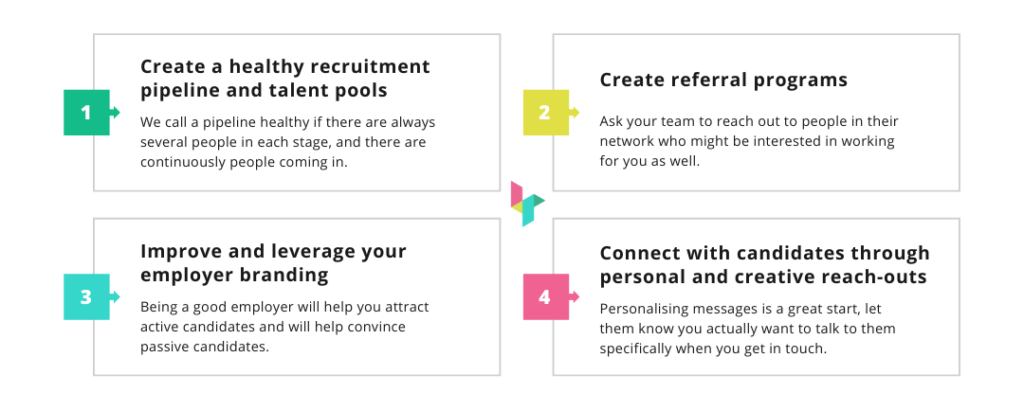So you posted your vacancy on LinkedIn, sat back and waited for the applications to come pouring in. That’s one way of doing it.
However, Joel Spolsky (founder of Stack Overflow) claims that on average developers only apply for four jobs in their entire career. You’re relying on a lot of luck if you hope that you’re hiring at the exact right moment for that one perfect developer. In these times, it’s more important than ever to actively look for candidates yourself.
Especially if you are a start-up or scale-up and are still building your employer brand, it may be hard for those candidates to find you in the first place.
What is Active Candidate Sourcing?
Here’s a mnemonic device that may only confuse things further. With active candidate sourcing, you are looking for passive candidates. With passive candidate sourcing, you will find the active candidates.
Active candidate sourcing means you are actively searching candidates for your role, instead of posting your job advert on online boards and waiting for candidates to apply. Thus, you are turning passive candidates into active candidates.
What is the difference between active and passive candidates?
In short: whether or not they are actually looking for a job.
Active candidates
Active candidates will apply to jobs that they find in their search for a new career opportunity. They will browse through job boards, they will network to get in touch with relevant recruiters and they will take the time to actually write a letter to accompany their resume in an application.
Usually, applicants cast a wide net, so they won’t always be a fit for the position that you’re trying to fill. Besides, they will only be available for a short period of time, as they are actually looking for a job – and may end up getting hired somewhere else before you’ve had a chance to include them in your process.
Passive candidates
Passive candidates (usually) already have jobs. They are not unhappy with their current situation and are in no need to find something new (and quick!). However, that does not mean that they are not interested in a conversation about another opportunity if it ticks all the boxes on the wishlist (even if they didn’t know they had a wishlist). With the right offer, any passive candidate can become active.
So the next question is…
Where do you find passive candidates?
How much would you hate me if I said everywhere right now? It’s true, but I will be more specific. Networking is always a great option. Where would your ideal candidate be? What would their interests be? Go hang out in those places to find them. Sure, some of them may be on LinkedIn too, but not all of them.
If you’ve ever heard a recruiter say that they’ve been sourcing all day, that means that they have been scouring the internet for candidates that fit the profile that they need to match a vacancy. There are many different ways of sourcing candidates (by networking, online, events, etc.) Often this search for candidates is only done after the discovery that there is a need for a certain profile. However, sourcing for a profile even before the need has risen can add a lot of benefits (and speed) to the process later on.
Building relationships is at the core of active candidate sourcing. Even if someone isn’t right at this time, or if they are not looking for something new, all of that may change at some point. It’s nice to already have the connection when that happens.
4 Tips for a successful active candidate sourcing strategy
1.Create a healthy recruitment pipeline and talent pools
Maybe you’ve heard talk of pipelines in recruitment and just kept seeing Mario jumping up and down in a land that’s full of them. The recruitment pipeline refers to the number of people in each of the stages of the recruitment process, something you can keep track of in an applicant tracking system.
We call a pipeline healthy if there are always several people in each stage, and there are continuously people coming in.
If you are just waiting for adequate applicants, your pipeline may dry up pretty quickly (and then you actually need Mario’s help!).
If you only start looking for passive talent when you need to fill a vacant position in your company, it may be too late. That’s where talent pools come in (I’m sure they are connected by pipes too, but I’ll leave Mario out of this one). A talent pool is a pre-made selection of people whose skills or experiences you may need or want at some point. This is something you can always work on.
Maybe you’ve had chats with good candidates, but for some reason, it didn’t work out? Or you’ve found a few profiles that would fit the company really well, but maybe would not fit a specific vacancy? Perhaps a candidate sent in an application but you had no open roles? All of these candidates can be added to a talent pool so you can easily reach out to them in the future. Of course, you should ask them if they are okay with that first.
2. Create referral programs
I’m sure you feel proud when you look around and see the amazing team of people you’ve gathered to join your company’s mission. All of them are all-stars that you selected. Do you know what is the great thing about the people in your team? They know other amazing people. And happy employees make for fantastic referrers.
Ask your team to reach out to people in their network who might be interested in working for you as well.
They may know some great all-rounders, but even people with the specific skill set that you need in the business right now. You could even start working with incentives and offer your employees a reward if they introduce you to the perfect candidate (and they end up getting hired).
3. Improve and leverage your employer branding
We’ve talked about how important a well-established employer branding strategy before.
Being a good employer will help you attract active candidates and will help convince passive candidates.
If they have never heard of you or have only heard bad things, it’s going to be ten times harder.
This also means having a good candidate experience. How? Give them feedback, keep them informed and if it didn’t work out, let them know! Otherwise not only will they never apply again, but they will definitely not recommend your company to their connections.
4. Connect with candidates through personal and creative reach-outs
When you are ready to actually reach out to passive candidates, a simple copy-paste message will not win people over easily. If you are looking for someone with a certain skill set that is important to your business, chances are that more companies are looking for them. Nowadays developers receive tons of messages from recruiters, so standing out is a skill and an art form.
Personalising messages is a great start, let them know you actually want to talk to them specifically when you get in touch.
Adding creative touches to your message or the job opening like infographics or other visuals will make your reach out more memorable.
This article may have shown you that it’s almost impossible to find great talent if you just wait for them to come to you. To be successful in your talent strategy you need to do both. Are you already looking for candidates actively? Feel free to reach out to us if you need any help in this area. We’ve done it many times and would love to help you too.


